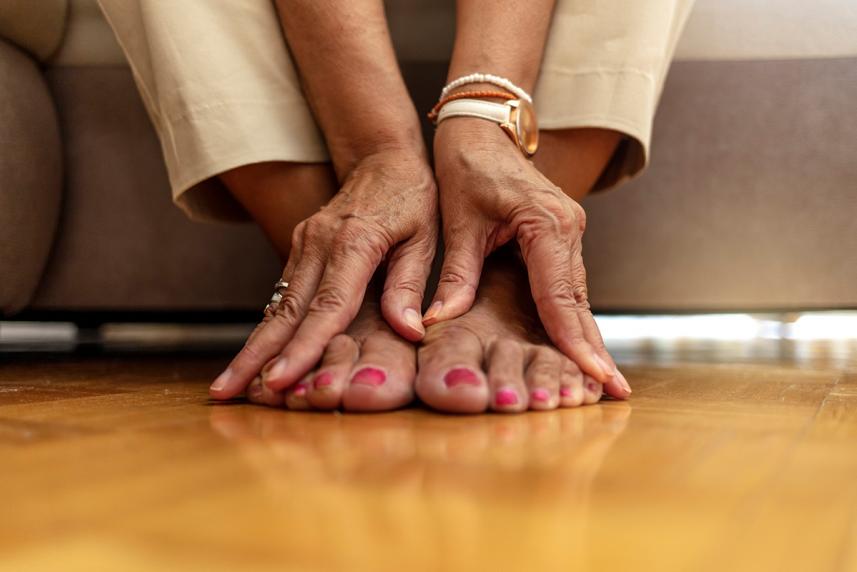How to care for your feet when you have diabetes
Simple foot problems can become complicated fast with diabetes. Learn what to do every day to ward off infections and other issues.

Diabetes can affect many parts of the body, including the heart, kidneys, eyes, and feet. Even ordinary foot problems like corns and calluses can lead to serious complications in people with diabetes, which is why proper foot care is essential.
Here, learn how diabetes impacts your feet and what you need to do to keep them healthy.
How does diabetes affect the feet?
Over time, high blood sugar can damage the body’s nerves, especially those in your legs and feet. Nerve damage (neuropathy) can cause you to experience tingling, pain, and loss of feeling in your feet. And if you can’t feel anything in your feet, you may not know if you have an open sore (ulcer), blister, or cut until it gets infected.
Diabetes also causes blood vessels to narrow and harden, resulting in poor circulation or blood flow. Inadequate circulation makes it more difficult for your foot to fight infection. Having an infection and poor blood flow can lead to gangrene, which is when the muscle, tissues, and skin begin to die. If gangrene isn’t treated immediately, it could put you at risk of amputation.
Did you know HMSA members have access to personalized support to help you manage your health and well-being? Learn more here.
Your daily footcare checklist
Along with monitoring your blood sugar levels, checking your feet should be on your daily to-do-list. Be sure to incorporate these steps into your diabetes care plan:
Inspect your feet daily
Look for cuts, sores, blisters, corns, calluses, any redness, swelling, warm spots, or nail problems. Be sure to check between your toes. If you can’t see the bottom of your feet, try using a magnifying mirror or ask someone to look at them. If you notice anything unusual or concerning, contact your doctor.
Wash, but don’t soak, your feet
Use a soft washcloth every day in warm, not hot, water. Dry your feet gently and completely, especially between your toes. Apply moisturizing lotion to your feet to keep dry skin from itching and cracking. Be careful to avoid putting lotion between your toes since doing so could encourage a fungal infection. Instead, apply talcum powder or cornstarch, which will keep skin dry to prevent an infection, says the National Institute of Diabetes and Digestive and Kidney Diseases.
Don’t walk around barefoot
Always wear shoes or slippers so you don’t step on anything that could result in a cut or other injury.
Wear well-fitting, comfortable shoes
Shoes that don’t fit right can cause blisters that can become infected. For the best fit, try on new shoes at the end of the day when your feet tend to be largest. Break in new shoes slowly — wear them for an hour or two a day at first until they feel completely comfortable.

Automatic refills and our mail-order program are easy to set up and can save you money.
Check the insides of your shoes
Look out for any pebbles or other objects and ensure the lining of your footwear is smooth. People with numbness in their feet may not feel anything within the shoe that could cause a cut or injury.
Trim your toenails when needed
Using toenail clippers, cut your nails straight across and do not cut into the corners of your toenails. Gently smooth any sharp edges with an emery board or unsharp nail file. If you don’t feel comfortable trimming your nails yourself, or can’t see or reach your feet, see your podiatrist (foot doctor), who can cut them for you.
Avoid removing corns or calluses with over-the-counter products
These products can damage or burn your skin and cause an infection. Use a pumice stone on wet skin to help keep calluses under control or leave the corn and callus treatments to your foot doctor.
Get your feet checked at every health care exam
Visit your foot doctor yearly for a complete exam and more frequently if you have nerve damage. Make sure your physician checks for feeling and blood flow in your feet. The Centers for Disease Control and Prevention advises that if you see any of the following symptoms, don’t wait until your regular appointment. See your doctor right away:
- A change in the shape of your feet over time
- Feet that are a different color or temperature
- Cramps in your calves, thighs, or buttocks or pain in your legs during physical activity
- Thickened, yellow toenails
- Burning, tingling, or pain in your feet
- Loss of sense of touch or ability to feel heat or cold very well
- Cracked, dry skin on your feet
Always wear clean and dry socks
Excessive moisture from perspiration can cause fungal infections, so you’ll want to change your socks if they’re damp or dirty. Even better, consider buying socks made specifically for people with diabetes. These socks feature extra cushioning, don’t have elastic tops, are higher than the ankle, and are made of moisture wicking material.
Keep moving
During the day, it’s important to make sure blood continues flowing to your feet. Elevate them while sitting, wiggle your toes several times during the day, and incorporate physical activities that are easy on your feet, such as walking, swimming, and bike riding. Check with your podiatrist about which activities are best for you and which ones you should avoid.
Sources:
Diabetes and foot problems: National Institute of Diabetes and Digestive and Kidney Diseases; Medlineplus.gov
Diabetes foot care guidelines and tips: American College of Foot and Ankle Surgeons; Mayo Clinic; American Diabetes Association
Diabetes and your feet: Centers for Disease Control and Prevention
Health effects caused by smoking: American Lung Association
Smoking and diabetes: Centers for Disease Control and Prevention
Diabetes and your eyes, heart, nerves, feet, and kidneys: National Kidney Foundation
H8481_8750_1295101_3MC2200_26_C | H3832_8750_1295101_3MCB2178_26_C
© 2025, Linkwell Health, Inc. All content owned or licensed by Linkwell Health, Inc. All rights reserved.
